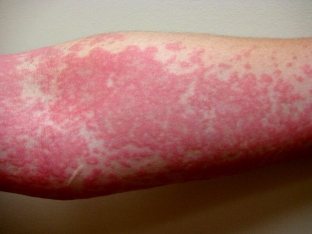Chronic urticaria has become an urgent problem in allergology and dermatology, as the number of patients with this disease is constantly increasing. This is due to a decrease in the reactivity of the body, as well as a sharp change in nutrition and the use of an increasing amount of products with GMOs and chemical compounds. Diagnosis and treatment of chronic urticaria should be dealt with at the first symptoms of the disease. How to diagnose, and what are the principles of treatment of chronic urticaria, read further in our article.
Diagnostics and principles of treatment of chronic urticaria
Studies have proven the ability of functional autoantibodies to activate skin basophils and mast cells. In vivo, this is manifested by hyperemia and the development of a blister at the site of intradermal injection of autologous serum, in vitro it is manifested by a process that is the "gold standard of diagnosis"; - Under the action of serum in a patient with chronic idiopathic urticaria, histamine is released.
To detect autoimmune urticaria, a screening method is used with a skin test with autologous serum. Positive is an intradermal test with histamine at a dose of 10 mg / ml.
Local immunological response is assessed after 15 and 40 minutes. A negative result indicates the absence of autoimmune response mechanisms, a positive result indicates its presence only in 25-40% of cases. After evaluating the test, a treatment for chronic urticaria is selected.

Principles of treatment of chronic urticaria:
- detection of causes and their elimination;
- relief of exacerbation with antihistamines and glucocorticosteroids, as well as detoxification;
- choice of basic therapy (antileukotriene drugs, corticosteroids, anti-inflammatory, selective H1 - histamine blockers);
- treatment of comorbidity that may be the etiological factor of urticaria;
- prevention of urticaria.
Difficulties and features of the treatment of chronic urticaria
Physicians may have difficulty in treating chronic urticaria due to the possible lack of clinical efficacy of antihistamines. However, clinical practice shows that the treatment of chronic urticaria begins with the use of antihistamines, regardless of the involvement of autoimmune mechanisms. The main methods of treating chronic urticaria read further on estet-portal.com. In patients with autoimmune urticaria, a more severe course of the disease is observed in combination with a low effectiveness of antihistamines. Then it is advisable to prescribe systemic glucocorticosteroids.
A distinctive feature of the immunological activation of mast cells in autoimmune urticaria is the formation of a "late phase" response.
In this case, it is necessary to prescribe corticosteroids that do not have an effect on the immunological activation of mast cells, but which prevent the formation of cellular infiltrate. Therefore, the treatment of chronic urticaria resembles the treatment of allergic rhinitis and asthma when it is important to act on the "late phase" response.
Basic treatments for chronic urticaria
When prescribing treatment for autoimmune urticaria, it should not be considered as an allergic reaction. The therapeutic target for chronic autoimmune urticaria is inflammation that has developed as a result of autoimmune processes, and not true allergic.
Treatment of chronic moderate urticaria is carried out using different groups of drugs, as well as treatment of acute urticaria. The severe course of autoimmune urticaria requires the appointment of such procedures as intravenous administration of immunoglobulins, plasmapheresis, the use of cyclosporine-A and corticosteroids. If it is necessary to prescribe systemic corticosteroids, only short courses of prednisone in a daily dose of not more than 40 mg for 5-7 days are acceptable. Long-term use of corticosteroids is not recommended in order to prevent side effects. Exacerbation of chronic urticaria is also possible with the abolition of GCS.
Thus, in most cases, chronic urticaria has an autoimmune origin. Treatment of chronic urticaria consists of plasmapheresis, intravenous administration of immunoglobulins and the appointment of cyclosporine – A and GKS.







Add a comment